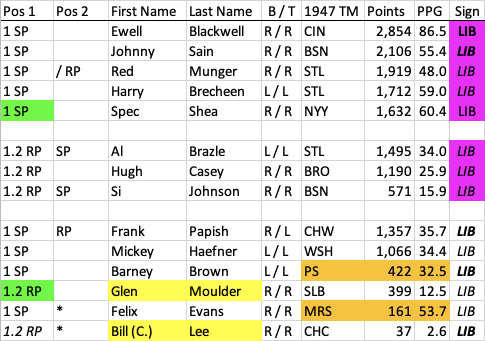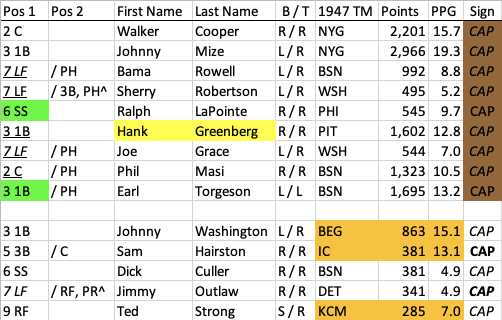1947 Fantasy Astrology Recap
View the 1947 FABL Lineups Here!
1947 is year two of including Negro League players in my Astrology All-Time Database, and it has inspired some mixed feelings. On the one hand, it’s great to analyze the statistics and learn the history of the best Black and Latin players of the day. But it’s also frustrating to see how much these players could have accomplished were they not excluded from the established Major League ranks at the time. It's more than just wanting to see what star players like Henry Kimbro (1,411 / 22.0) and Max Manning (1,341 / 67.1) could have done with a full 154-game schedule – it’s about the lack of respect and dignity shown to human beings simply because of their skin color.
In Fantasy Astrology terms, 1947 had none of the turmoil of the 1948 final standings, with the four top-scoring signs also the four division winners. Once again, Scorpio could not be stopped, with Bob Feller (2,923 / 69.6) scoring the most fantasy points among all pitchers and Ralph Kiner (2,850 / 18.8) leading a stellar offense. And the Stingers only get better when considering the Negro Leagues: while Buck O’Neill (1,007 / 16.8) had his final stat line suppressed by the Kansas City Monarchs’ short season, he’d be a much better fit in the lineup at DH than rookie third baseman Spider Jorgensen (1,344 / 10.4), despite the latter’s 80-grade name. And pitchers Max Manning (1,341 / 67.1) and Frank Thompson (1,017 / 59.8) would make the rotation, even despite the short schedules of the Newark Eagles and the Homestead Grays, respectively.
The second-place Libra Scales also had a key Negro League participant in their lineup: rookie Jim Gilliam (684 / 11.6) would slot in at second base, with not a single AL/NL player qualifying at the position. Ironically, he would take the same Fantasy Astrology field as Dixie Walker (1,928 / 13.0), who famously tried to stop Jackie Robinson from joining the Dodgers. But the real strength of Libra was their pitching staff, as Ewell Blackwell (2,854 / 86.5) had the best season among Positive Polarity pitchers, and Al Brazle (1,495 / 34.0) was the top Positive reliever. (Going back to Scorpio briefly, Joe Page (2,003 / 35.8) of the Yankees scored the most points of any reliever, in an era when dedicated closers weren’t really a thing.)
Aries made the playoffs in 1947 thanks to a relatively unsung hero, with Cardinals third baseman Whitey Kurowski (2,341 / 16.0) serving as their offensive leader. While Kurowski and Emil “Dutch” Leonard (2,059 / 64.3) were their only 2,000 point scorers, consistency was key for the Rams: only two players in their lineup/rotation/bullpen scored less than 1,000 points on the year, and one of them was Hall of Fame catcher Ernie Lombardi (318 / 6.6), who will solidify the position for many years going reverse-chronologically. As far as Negro League reinforcements, third baseman/left fielder Lester Lockett (895 / 13.4), first baseman George Crowe (382 / 14.1), right fielder Pedro Formental (219 / 14.6) had great seasons from a points-per-game perspective.
Virgo was led by the incomparable Ted Williams (2,957 / 19.0) in left field, even though he narrowly missed out on the fantasy points crown to Capricorn first baseman Johnny Mize (2,966 / 19.3). But the Flowers also had remarkable consistency, with their #3 reliever the only player on their roster who failed to score 1,000 points. What’s more, Virgo had enough Negro League players to form a complete starting lineup AND a five-pitcher starting rotation (even if their #5 starter had a negative point total on the year). Some notables include Hall of Fame first baseman Buck Leonard (552 / 15.8) from the Homestead Grays, shortstop Tommy Butts (885 / 15.0) on the Baltimore Elite (pronounced EE-lite) Giants, and Monarchs outfielder Johnie Scott (793 / 12.2). On the pitching side, a couple of New York Cubans led the pack: Luis Tiant (942 / 67.3) - father of the Sagittarius pitcher of the same name who played from 1964 to 1982 - and Lino Donoso (887 / 68.2), who pitched with the Pittsburgh Pirates in 1955 and ’56.
While Aquarius didn’t make the playoffs in 1947, they were perhaps the most impactful sign that season. First baseman Jackie Robinson (2,131 / 14.1) famously broke the color barrier in what were considered the Major Leagues at the time. He made his debut on April 15th, the date on which his accomplishment is celebrated every year, with every player wearing Jackie’s retired number 42 on their jerseys. Not only that, Aquarius was also the sign of the Positive Polarity MVP in both White and Black baseball: New York Giants outfielder Willard Marshall (2,355 / 15.2) took home the AL/NL version of the trophy, while Baltimore Elite Giants center fielder Henry Kimbro (1,411 / 22.0) won the Negro Leagues version of the award.
It’s also worth mentioning the Cancer Crabs, the sign of top Negative Polarity Negro Leagues outfielder Willard Brown (1,314 / 19.0), who jumped to the St. Louis Browns for a brief cup of coffee in 1947, and became the first Black player to hit a home run in the American League. Cancer also boasted Negative Polarity Rookie of the Year Larry Jansen (2,257 / 53.7), meaning that the Crabs will be in dire straits as far as pitching goes as we move reverse-chronologically through history.




